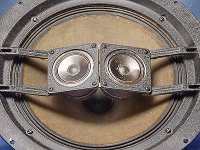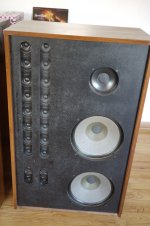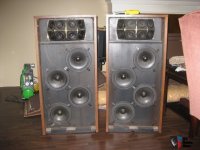Perceval,
Okay missing "Disk writer" option then remember somewhere over phantom image thread someone mentioned use Sox, other than that i could be wrong but think should be possible too with some investigation into Audacity where there is so many packages and plugins available and think especially if Taps/FFT length and also sample rate happen is same for the two IR-wav files to blend it should be possible.
wesayso,
Nice new left verse right results for phase, you have been in engine room to calibrate the two cylinder engine so ignition timing is in absolute sync now via "Phase EQ" tab, couldn't resist tweak your two carburetors vacuum throttle too just a little little bit on the next "Gain tab" shifting from default minimum-phase to linear-phase with small numbers in below graphs. With new dimension for system critical quality control have set new check mark : )
Most of the wiggles you highlight are room, not speaker induced. Using frequency dependent windowing is to leave out the room, but you can't completely of coarse. But don't fix it if it isn't the speaker. The right side lacks some damping panels. Don't blame me, I'm not allowed to put up more panels
In other words, you just don't want to fix everything with EQ. Fix what you can, but fixing those would not make sense. move an inch and they are somewhere else.
The plot you showed is not the base of EQ, it's a 1/12 oct 500 ms standard REW window (!). That's the whole key, fix that first wave front and the other plots will start to look pretty as well.
Thanks for the cheers and support though, much appreciated!
Last edited:
Still working on a bit more balance, phase and FR. This joining of FIR filters in JRiver is fun stuff. Even though my changes are minimal at most it seems to bring better balance. Maybe I'm just fooling myself though.
I figured I might as well plot the difference I have in mid and side EQ. I started with an "S" curve, as noted earlier in this thread but gradually changed it to something that looks like this (at the listening spot trough the speakers):

Now it may look (and is) only minor, the perceptual change was definitely worth it to me. This is the left speaker summed with the right one. Once plotted trough the mid EQ and the other trace trough the side EQ.
This is a plot with all processing in line. So it's a good reference of the tonal balance EQ I ended up with. Changed a bit since I added the ambient channels.
The graph is unsmoothed, though gated with a 5 cycle window.
I figured I might as well plot the difference I have in mid and side EQ. I started with an "S" curve, as noted earlier in this thread but gradually changed it to something that looks like this (at the listening spot trough the speakers):

Now it may look (and is) only minor, the perceptual change was definitely worth it to me. This is the left speaker summed with the right one. Once plotted trough the mid EQ and the other trace trough the side EQ.
This is a plot with all processing in line. So it's a good reference of the tonal balance EQ I ended up with. Changed a bit since I added the ambient channels.
The graph is unsmoothed, though gated with a 5 cycle window.
Geez Wesayso, Why would you even mess with that curve if that is the unsmoothed response! Yes someone may complain that it doesn't go out to 20khz but they better be pretty young to notice that. Looks like a textbook curvature of a downward sloping audio curve. I understand the shuffler experiment but to change anything else seems just crazy. Great work.
Thanks Steven,
I see I forgot the "Frequency Dependent" part between 5 cycle and window. Not everyone will agree on the merit of using that, I am sold however. The REW implementation is pretty smoothed though, I'd have to add that. When comparing different implementations it looks like a 1/3 octave smoothed version of a DRC-FIR 5 cycle window.
Putting the shuffler the other way got a slight wandering of the stage. So I tried to fix that by reviewing any differences there are between left and right. The biggest difference is more room influences in the right channel (less reflection absorption on that side).
I can compensate a bit with the ambient channel balance.
I haven't retested the shufflers yet, but was pretty impressed with the new balance I got.
I see I forgot the "Frequency Dependent" part between 5 cycle and window. Not everyone will agree on the merit of using that, I am sold however. The REW implementation is pretty smoothed though, I'd have to add that. When comparing different implementations it looks like a 1/3 octave smoothed version of a DRC-FIR 5 cycle window.
Putting the shuffler the other way got a slight wandering of the stage. So I tried to fix that by reviewing any differences there are between left and right. The biggest difference is more room influences in the right channel (less reflection absorption on that side).
I can compensate a bit with the ambient channel balance.
I haven't retested the shufflers yet, but was pretty impressed with the new balance I got.
So what did all this optimizing lead to, you may ask...
I want to give the phase shuffler a fair shake (no pun intended).
Here's the left/right balance, 5 cycle FDW:

Shuffler is included here.
The phase plots of the shuffler:

Both above plots 5 cycle FDW, no further smoothing (REW chooses 1/48 within the FDW mechanism)
And last but not least, the group delay:

Again 5 cycle FDW, this time smoothed 1/12 oct. No big time penalties...
I've listened to a few tracks, but I need way more time to say anything.
I like it, but might want to tweak/adjust a few things (tonal balance).
This shuffler is shuffling less in degrees than earlier ones. About 25 degree at 1850 Hz and 20 degree at 5500 Hz.
I want to give the phase shuffler a fair shake (no pun intended).
Here's the left/right balance, 5 cycle FDW:

Shuffler is included here.
The phase plots of the shuffler:

Both above plots 5 cycle FDW, no further smoothing (REW chooses 1/48 within the FDW mechanism)
And last but not least, the group delay:

Again 5 cycle FDW, this time smoothed 1/12 oct. No big time penalties...
I've listened to a few tracks, but I need way more time to say anything.
I like it, but might want to tweak/adjust a few things (tonal balance).
This shuffler is shuffling less in degrees than earlier ones. About 25 degree at 1850 Hz and 20 degree at 5500 Hz.
You remember this being a 5 cycle window, right? Now I could easily "force" the frequency response to be flat. But it wouldn't sound right. (believe me, I have tried it) There are a couple of different things happening that influence the direct sound, 3 post above it you can see the combined result, still a 5 cycle window. The lighter green line in that plot is the left + right signal combined.
In a longer REW window the energy gets evened out in each channel, some things just shouldn't be fixed with EQ. I'd need more damping panels and a bass trap, and this is just not going to happen. No permission for me to make our living room into a studio.
This balancing of the left and right channels is the best I can do. This way they still combine to a time coherent sound wave. As demonstrated with multiple APL_TDA plots scattered all trough this thread.
Here's a longer REW window of left and right 1/12 octave smoothed, no FDW:

You still see the switching of the low frequency load in the left and right array at ~60 Hz and the other way around at even lower frequencies. The left one is in a corner, the right one isn't. It's easier to get 30 Hz in that corner. This summing of low frequencies is completely even all throughout the listening area. I made sure of that. EQ-ing all to flat would disturb that and mess it up.
Perfect straight lines may look prettier, but I want it to sound good too!
In other words: feather the EQ, don't hammer it into shape .
.
In a longer REW window the energy gets evened out in each channel, some things just shouldn't be fixed with EQ. I'd need more damping panels and a bass trap, and this is just not going to happen. No permission for me to make our living room into a studio.
This balancing of the left and right channels is the best I can do. This way they still combine to a time coherent sound wave. As demonstrated with multiple APL_TDA plots scattered all trough this thread.
Here's a longer REW window of left and right 1/12 octave smoothed, no FDW:

You still see the switching of the low frequency load in the left and right array at ~60 Hz and the other way around at even lower frequencies. The left one is in a corner, the right one isn't. It's easier to get 30 Hz in that corner. This summing of low frequencies is completely even all throughout the listening area. I made sure of that. EQ-ing all to flat would disturb that and mess it up.
Perfect straight lines may look prettier, but I want it to sound good too!
In other words: feather the EQ, don't hammer it into shape
Not at all, look at the group delay plot, there's a 0.2 ms max time difference at max between the two and they alternate between left and right. That still puts the sound right in front of you, though with less than a head sized space between them at any time. As the head was cause for a 0.27 ms difference. 
I haven't tried swapping channels again with the shuffler. This one definitely flows better with the original phase curve of the separate speakers.
If a shuffler like this pulls apart the phantom center things must not have been right to begin with. Its just too little of a difference with 0.1ms delay or advance at maximum.
I haven't tried swapping channels again with the shuffler. This one definitely flows better with the original phase curve of the separate speakers.
If a shuffler like this pulls apart the phantom center things must not have been right to begin with. Its just too little of a difference with 0.1ms delay or advance at maximum.
Day one with about an hour and a half of fully listening to the new balance.
I couldn't help myself and put in a PEQ at 1850 Hz, q=2 gain=1dB. (based on the graph of left + right with shuffler activated) Sort of compensating for the lesser phase angle.
It convinced me on all tracks I listened to. Added clarity in the center. Time is up though, we'll see how this works long time. No fatigue, but great transportation into the songs, I loved every minute.
I keep coming back to Infected Mushroom's Converting Vegetarians II. What a great album. Lovely mixes that transport me. I never figured I'd like this type of music at all.
Way outside my usual genre. Though hints do exist to my mainstream listening with songs like Pink Froid.
The use of the low end on this album is just fantastic. It sets the mood, atmosphere...
Not many albums make such use of the low end. Do you guys notice how I'm talking about songs instead of my speakers? I was transported into the music. Isn't that the key?
Edit: one more thing to add... Once I catch myself singing the songs afterwards I know it worked... I bet I'll be singing for quite a bit today... (making sure no one is actually able to hear me, I'm not that good at it (lol))
I couldn't help myself and put in a PEQ at 1850 Hz, q=2 gain=1dB. (based on the graph of left + right with shuffler activated) Sort of compensating for the lesser phase angle.
It convinced me on all tracks I listened to. Added clarity in the center. Time is up though, we'll see how this works long time. No fatigue, but great transportation into the songs, I loved every minute.
I keep coming back to Infected Mushroom's Converting Vegetarians II. What a great album. Lovely mixes that transport me. I never figured I'd like this type of music at all.
Way outside my usual genre. Though hints do exist to my mainstream listening with songs like Pink Froid.
The use of the low end on this album is just fantastic. It sets the mood, atmosphere...
Not many albums make such use of the low end. Do you guys notice how I'm talking about songs instead of my speakers? I was transported into the music. Isn't that the key?
Edit: one more thing to add... Once I catch myself singing the songs afterwards I know it worked... I bet I'll be singing for quite a bit today... (making sure no one is actually able to hear me, I'm not that good at it (lol))
Last edited:
I was transported into the music.
Funny I had that experience with my car setup and after my hearing improved. The trick is to concentrate on the music at the moment and all of the sounds you hear instead of trying to remember or anticipate the next note.
Pink Froid is a great tribute to Pink Floyd.
You can even get drawn into the music from a kitchen radio  ...
...
Though having a clear and pleasant sound all around you surely helps with the ease of getting pulled in.
I agree, Pink Froid is nicely done... But I love many little details in that whole album.
Though today I played some Crosby, Stills and Nash and that worked too.
Though having a clear and pleasant sound all around you surely helps with the ease of getting pulled in.
I agree, Pink Froid is nicely done... But I love many little details in that whole album.
Though today I played some Crosby, Stills and Nash and that worked too.
Looking ahead to get a bit of time to play tomorrow. Hoping to restore some of the tonal balance that changed due to the shuffler. Nothing much needed I think, but time will tell.
I did notice a change on some songs, while others sounded fine. It's always hard to fight the urge just to fix the #@## songs that don't work as well (lol).
It's not easy to find a balance that fits most songs. Even if the changes the shuffler brings are only minor. If it doesn't work I have some ideas for a (small) change of the shuffler itself.
I did notice a change on some songs, while others sounded fine. It's always hard to fight the urge just to fix the #@## songs that don't work as well (lol).
It's not easy to find a balance that fits most songs. Even if the changes the shuffler brings are only minor. If it doesn't work I have some ideas for a (small) change of the shuffler itself.
Well I got my time in listening and enjoying myself. Played everything I could think of and got lost in some Zappa albums. Really enjoying myself and lots of shivers down the spine.
Then I decided to play a movie, still in stereo but at the same level (usually tun it down a bit), only listening. The intro from Rango. Man that scared me! The first gun shot made me jump up and the later crash of the aquarium, falling to bits again had me completely in shock! What a little volume can do.
So far: the shuffler stays! Still early but it is convincing me, bit by bit.
No more time today, looking forward to my next session!
Then I decided to play a movie, still in stereo but at the same level (usually tun it down a bit), only listening. The intro from Rango. Man that scared me! The first gun shot made me jump up and the later crash of the aquarium, falling to bits again had me completely in shock! What a little volume can do.
So far: the shuffler stays! Still early but it is convincing me, bit by bit.
No more time today, looking forward to my next session!
Thanks Perceval, I guess if it's interesting enough, I'll keep on experimenting  .
.
I figured I might as well make a case of presenting the data for my array IR instead of the earlier Dirac pulses.
Here's what the shuffler presents at the ears vs what we measure with the microphone. You'd first hear the top line, and after 0.27ms get the combing from the sounds of the left speaker traveling to the right ear, and the sound of the right speaker traveling to the left ear, each of them combing with the direct sound. Of coarse our head is in the middle of it, shading some of this effect.

This isn't an array thing. The better your room behaves in those early milliseconds the more you'll be able to notice a "duller" sound of the phantom center at the exact sweet spot. Moving your head just a tiny bit off axis and it fills the dip at ~1850 Hz, 5500 Hz etc... The above graph is with the shuffler in place. This is a minimal shuffler with 2 phase bumps:

With minimal group delay:

It might explain why a lot of people like a "BBC dip". Even if the original function of that BBC dip was for an entirely different reason and the name got re-used completely out of context. And why I like to have my side (from mid-side processing) drop off slightly on the top end.
This above presentation is a worst case scenario with a fix in action. Comparable to the earlier plots made with Dirac pulses:

Without the shuffler I would have gotten deep dips at 1850 Hz, 5500 Hz like the purple line in this Dirac pulse example.
I figured I might as well make a case of presenting the data for my array IR instead of the earlier Dirac pulses.
Here's what the shuffler presents at the ears vs what we measure with the microphone. You'd first hear the top line, and after 0.27ms get the combing from the sounds of the left speaker traveling to the right ear, and the sound of the right speaker traveling to the left ear, each of them combing with the direct sound. Of coarse our head is in the middle of it, shading some of this effect.

This isn't an array thing. The better your room behaves in those early milliseconds the more you'll be able to notice a "duller" sound of the phantom center at the exact sweet spot. Moving your head just a tiny bit off axis and it fills the dip at ~1850 Hz, 5500 Hz etc... The above graph is with the shuffler in place. This is a minimal shuffler with 2 phase bumps:

With minimal group delay:

It might explain why a lot of people like a "BBC dip". Even if the original function of that BBC dip was for an entirely different reason and the name got re-used completely out of context. And why I like to have my side (from mid-side processing) drop off slightly on the top end.
This above presentation is a worst case scenario with a fix in action. Comparable to the earlier plots made with Dirac pulses:

Without the shuffler I would have gotten deep dips at 1850 Hz, 5500 Hz like the purple line in this Dirac pulse example.
Last edited:
The last picture shows an earlier shuffler, I only shuffle at 1850 Hz and less at 5500 Hz, no more after that. At 5500 Hz it only prevents a deep dip but doesn't fill in the dip like at 1850 Hz. As intended, I believe the dip at 1850 Hz to be the most bothersome.
In the top post of my previous reply you can see the (very light) grey shifted comb null's and that shows there's no shifting any higher than 5500 Hz.
So I only target the biggest offenders. Added the one at 5500 Hz for another reason actually. The group delay plot might explain that.
In the top post of my previous reply you can see the (very light) grey shifted comb null's and that shows there's no shifting any higher than 5500 Hz.
So I only target the biggest offenders. Added the one at 5500 Hz for another reason actually. The group delay plot might explain that.
I wonder if having two tweeters, horizontally arranged, maybe 6 inches apart, on each side, might do something similar to what the shuffler is trying to do? One tweeter has a problem with two ears, so two tweeters might have either twice as big a problem, or possibly almost no problem at all (?) My brain keeps telling me "math overload"... Too busy with too many projects right now to handle the math of such a thing.
Bozak did tweeters something like that back in the 1950's, but with 2 inch cone tweeters horizontally adjacent and aimed slightly outward. I tried that in one speaker system I built back in the 1970's and thought it sounded good (no obvious comb filter effects - but I wasn't really listening close for center image clarity).(this is the wrong thread for this, isn't it?)
Bozak did tweeters something like that back in the 1950's, but with 2 inch cone tweeters horizontally adjacent and aimed slightly outward. I tried that in one speaker system I built back in the 1970's and thought it sounded good (no obvious comb filter effects - but I wasn't really listening close for center image clarity).(this is the wrong thread for this, isn't it?)
Attachments
Last edited:
If I look at this one:
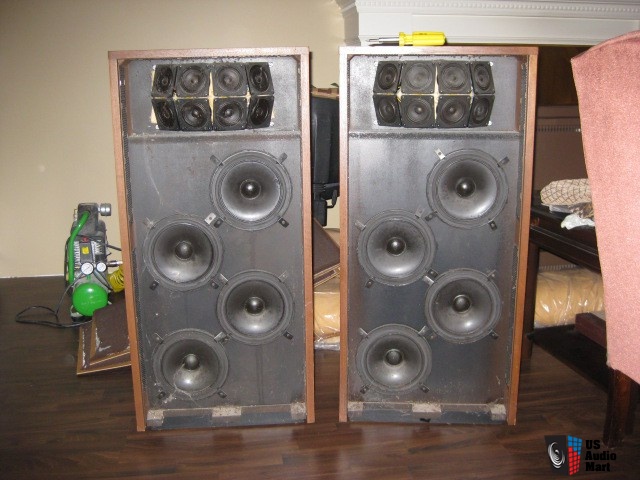
It sort of reminds me of Pano's Altec setup:
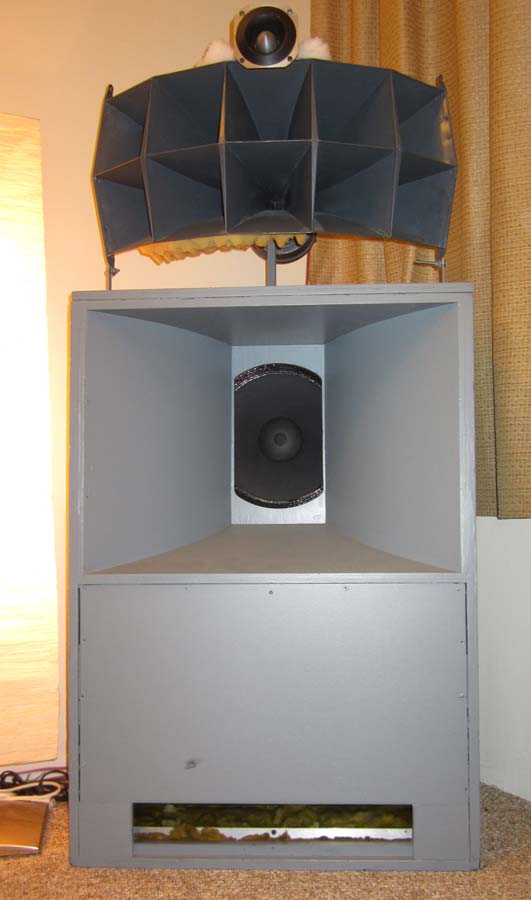
We know even that one needed a shuffler, so I think this wouldn't help.
I'm still wondering how our ears work to process this though. Real sound from straight ahead wouldn't have the time delay you get with a phantom center.
I wonder if that's of influence at all. It doesn't seem to be the main point of identification, yet we do pick up on reflections to determine a position or origin of a sound.

It sort of reminds me of Pano's Altec setup:

We know even that one needed a shuffler, so I think this wouldn't help.
I'm still wondering how our ears work to process this though. Real sound from straight ahead wouldn't have the time delay you get with a phantom center.
I wonder if that's of influence at all. It doesn't seem to be the main point of identification, yet we do pick up on reflections to determine a position or origin of a sound.
Last edited:
- Home
- Loudspeakers
- Full Range
- The making of: The Two Towers (a 25 driver Full Range line array)
